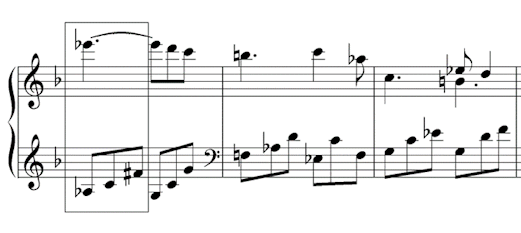Identifying the Prevailing Key
To work out the prevailing key at any point in a piece of music, remember that chords generally belong to one of three types:
- tonic chords – these tell you the name of the key,
- dominant chords, or substitute dominants- these allow you to identify which is the tonic chord because they move towards it,
- and pre-dominant chords – these are all the other chords, including the chromatic chords such as the augmented and Neapolitan 6ths. They tend to move to a dominant-type chord.
These 2 bars are from “The Girl with the Flaxen Hair” by Debussy. What is the chord in the box?

- The chord notes are Gb-Cb-Fb-Ab and Db, with lots of duplicates.
- It is not possible to stack these in thirds, which means we’ll presume it’s an extended dominant. Check the bass line and you’ll see Gb followed by Cb, so this is going to be in Cb, and the dominant chord is Gb.
- The chord contains: Gb, Db; Fb, which is the 7th; Ab, which is the 9th and Cb, which is the 11th, and it’s in root position, so this one is V11a
- The key is Cb major, because the next chord has the notes Cb, Eb and Gb!
This one is taken from the third movement of Mozart’s piano sonata No.12, K332.

- The chord notes are Ab-C-F# and Eb
- Stacked in thirds they are F#-Ab-C-Eb, So there’s a diminished 3rd between F# and Ab.
- Reorganise the chord to find the tonic, which is C, and the 4th note is a minor 3rd higher, so it’s a German 6th.
- German 6ths are normally followed by Ic, and this one is followed by C minor in second inversion, so the key is also C minor.